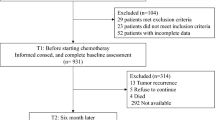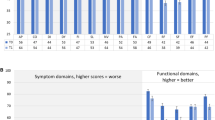Abstract
A cohort study was conducted to investigate the construct validity of the domains of the EORTC QLQ-C30 (European Organization for the Research and Treatment of Cancer Quality of Life Questionnaire). Ninety-six patients undergoing chemotherapy at the Kingston Regional Cancer Centre, Kingston, Canada were given the EORTC QLQ-C30 and two out of four comparison scales; the Sickness Impact Profile, the McGill Pain Questionnaire, the General Health Questionnaire and the Cancer Rehabilitation Evaluation System, to complete during their clinic visits. Using the multitrait-multimethod matrix to examine relationships, the Spearman ranked correlation coefficients of similar and dissimilar domains between the EORTC QLQ-C30 and the comparison scales were compared. The EORTC QLQ-C30 domains of pain and physical and role functioning performed well in that they converged and diverged appropriately with the other instruments. The domain of psychological functioning had strong associations with domains thought to be dissimilar (social interaction and fatigue). Social interaction and financial impact diverged across dissimilar domains. This lack of specificity may relate to question wording. The symptom domain had strong associations with other domains across the comparison scales. This study shows that the domains of the EORTC QLQ-C30 have substantial construct validity in the multidimensional assessment of the quality of life of cancer patients and identifies where further work is required.
Similar content being viewed by others
References
World Health Organization. The Constitution of the World Health Organization. WHO Chronicles 1947; 1(29). In: Aaronson, NK Quality of life assessment in clinical trials: methodologic issues. Controlled Clin Trials 1989; 10: 195S–208S.
AaronsonNK, BullingerM, AhmedzaiS. A modular approach to quality of life assessment in cancer clinical trials. Rec Res Cancer Res, 1988, 111: 213.
SpilkerB, ed. Quality of Life Assessment in Clinical Trials. New York: Raven Press, 1990.
DeHaesJCJM, VanKnippernbergFCE. The quality of life of cancer patients: a review of the literature. Soc Sci Med 1985; 20: 809–817.
OchsJ, MulhernR, KunL. Quality-of-life assessment in cancer patients. Am J Clin Oncol 1988; 11: 415–421.
MoinpourCM, FeiglP, MetchB, HaydenKA, MeyskensFLJr, CrowleyJ. Quality of life endpoints in cancer clinical trials: review and recommendations. J Natl Cancer Inst 1989; 81: 485–495.
WareJE. Standard for validating health measures: definition and content. J Chronic Dis 1987; 40: 473–480.
MaguireP, SelbyP. Assessing quality of life in cancer patients. Br J Cancer 1989; 60: 437–440.
AaronsonNK, AhmedzaiS, BullingerM, et al. The EORTC core quality of life questionnaire: interim results of an international field study. In: OsobaD (ed.) Effect of Cancer on Quality of Life Boston; CRC Press, 1991: 185–203.
AaronsonNK, AhmedzaiS, BergmanB, et al. The European Organization for Research and Treatment of Cancer QLQ-C30: a quality-of-life instrument for use in international clinical trials in oncology. J Natl Cancer Inst 1993; 85: 365–376.
McDowellI, NewellC. Measuring Health: A Guide to Rating Scales and Questionnaires. Oxford University Press: New York, 1987.
SelbyP. Measuring the quality of life of patients with cancer. In: WalkerSR (ed.). Quality of Life: Assessment and Applications. Lancaster: MTP Press Limited, 1988: 181–203.
GanzPA, SchagCC, ChengHL. Assessing the quality of life—a study in newly diagnosed breast cancer patients. J Clin Epidemiol 1990; 43: 75–86.
HeinrichRL, SchagCC, GanzPA. Living with cancer: the cancer inventory of problem situations. J Clin Psychol 1984; 40: 972–980.
SchagCC, HeinrichRL, GanzPA. Cancer inventory of problem situations: an instrument for assessing cancer patients' rehabilitation needs. J Psychosoc Oncol 1983; 1: 11–24.
GanzPA, SchagCA, LeeJJ, et al. The CARES: a generic measure of health-related quality of life for patients with cancer. Qual Life Res 1992; 1: 19–29.
SchipperH, ClinchJ, McMurrayA, LevittM. Measuring the quality of life of cancer patients: the functional living index-cancer: development and validation. J Clin Oncol 1984; 2: 472–483.
MelzackR. The McGill Pain Questionnaire: major properties and scoring methods. Pain 1975; 1: 277–294.
WilkieDJ, SavedraMC, HolzemerWL, TeslerMD, PaulSM. Use of the McGill Pain Questionnaire to measure pain: a meta-analysis. Nurs Res 1990; 30: 36–41.
GreenwaldHP. The specificity of quality of life measures among the seriously ill. Med Care 1987; 25: 642–651.
GoldbergD, WilliamsP. A User's Guide to the General Health Questionnaire. NFER-Nelson: Great Britain: 1988.
AlthauserRP, HeberleinTA. Validity and the multitrait-multimethod matrix. In: BorgattaEF (ed.) Sociological Methodology. San Francisco, Jossey-Bass Inc.: 1970: 151–169.
MorrowGR. Clinical trials in psychosocial medicine: methodological and statistical considerations. Part III. Assessing measurement techniques in psychosocial oncology. Cancer Treat Rep 1980; 64: 451–456.
CampbellDT, FiskeDW. Convergent and discriminant validation by the multitrait-multimethod matrix. Psychol Bull 1959; 56: 81–105.
PaulSR. Test for the equality of several correlation coefficients. Can J Stat 1989; 17: 217–227.
RosnerB. Fundamentals of Biostatistics. 3rd ed. Boston; Pws-Kent Publishing Company, 1990.
Author information
Authors and Affiliations
Rights and permissions
About this article
Cite this article
Niezgoda, H.E., Pater, J.L. A validation study of the domains of the core EORTC Quality of Life Questionnaire. Qual Life Res 2, 319–325 (1993). https://doi.org/10.1007/BF00449426
Received:
Accepted:
Issue Date:
DOI: https://doi.org/10.1007/BF00449426




